Abstract
Resistance to adenine analogs such as 2,6-diaminopurine occurs at a rate of approximately 10(-3) per cell per generation in mouse L cells. This resistance is associated with a loss of detectable adenine phosphoribosyltransferase activity. Other genetic loci in L cells have the expected mutation frequency (approximately 10(-6)). Transformation of L cell mutants with Chinese hamster ovary cell DNA results in transformants with adenine phosphoribosyltransferase activity characteristic of Chinese hamster ovary cells. No activation of the mouse gene occurs on hybridization with human fibroblasts. That this high frequency event is the result of mutation rather than an epigenetic event is supported by antigenic and reversion studies of the 2,6-diaminopurine-resistant clones. These results are consistent with either a mutational hot-spot, a locus specific mutator gene, or a site of integration of an insertion sequence.
Full text
PDF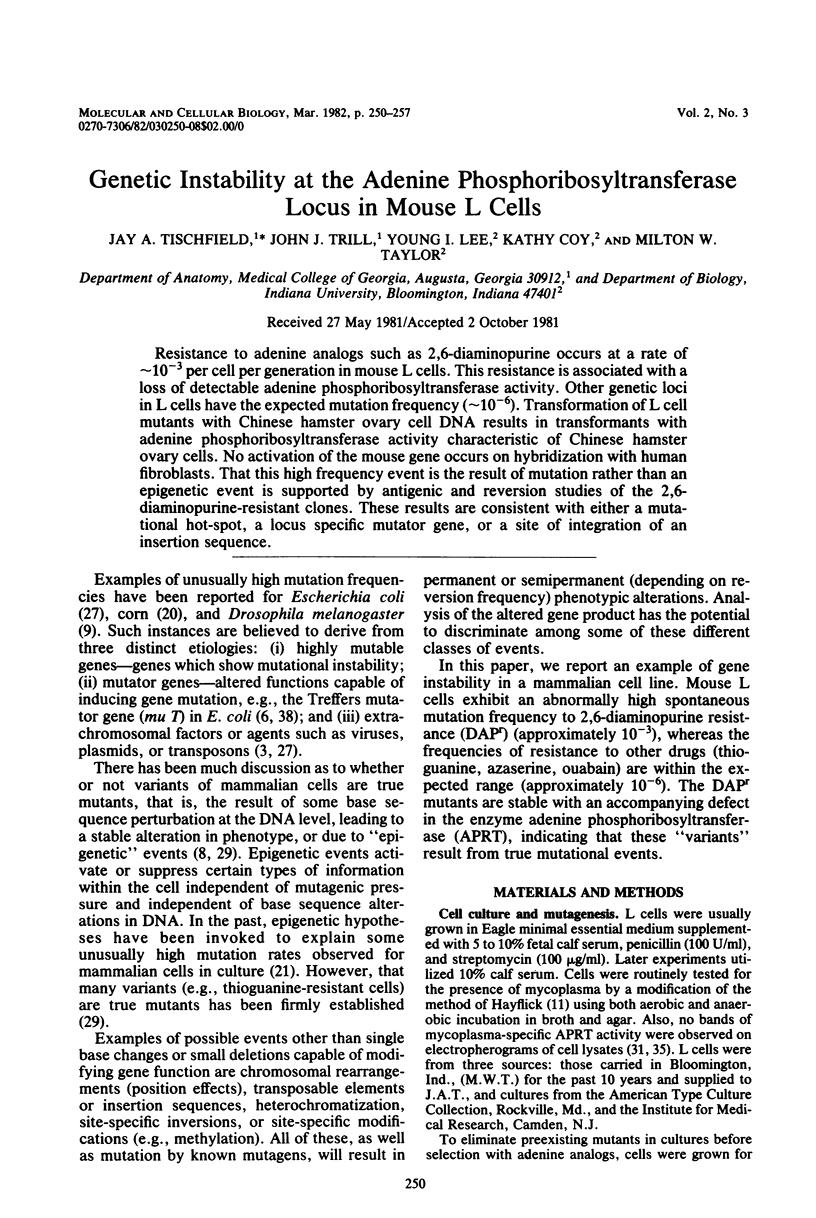
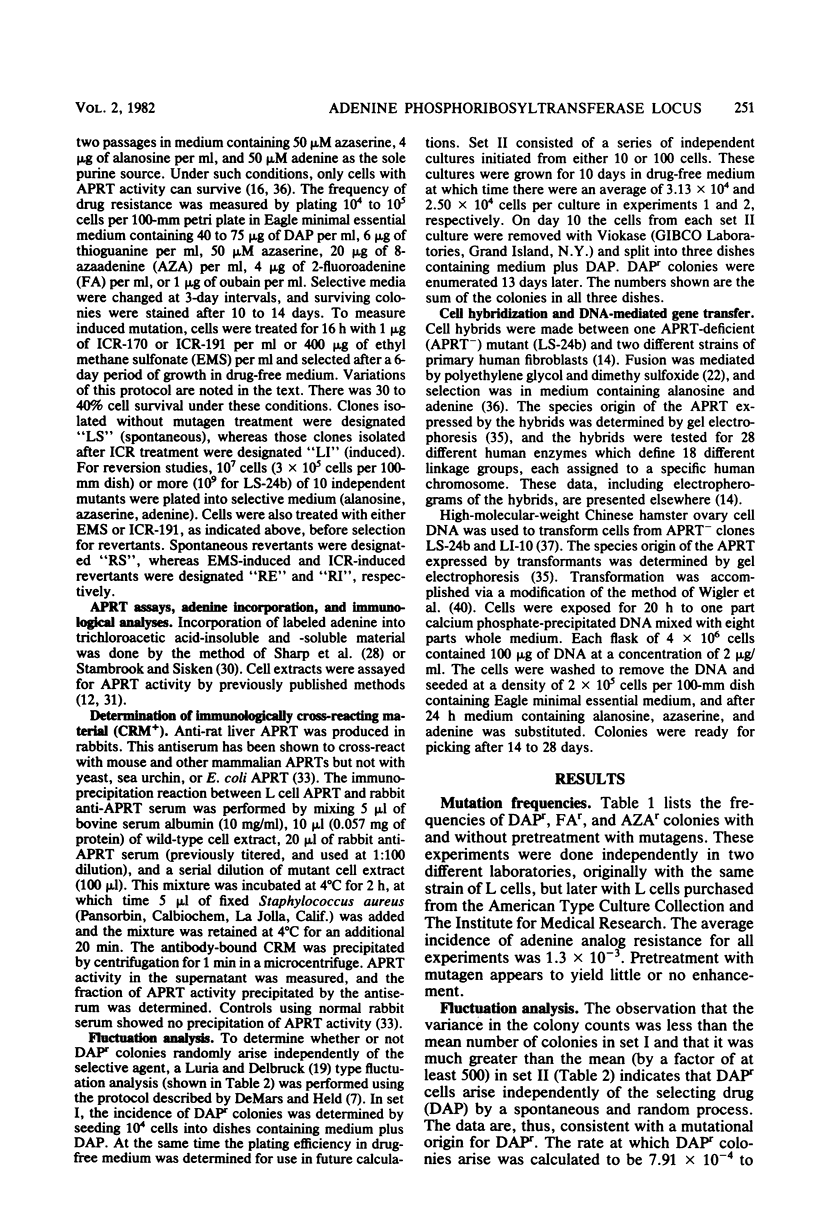
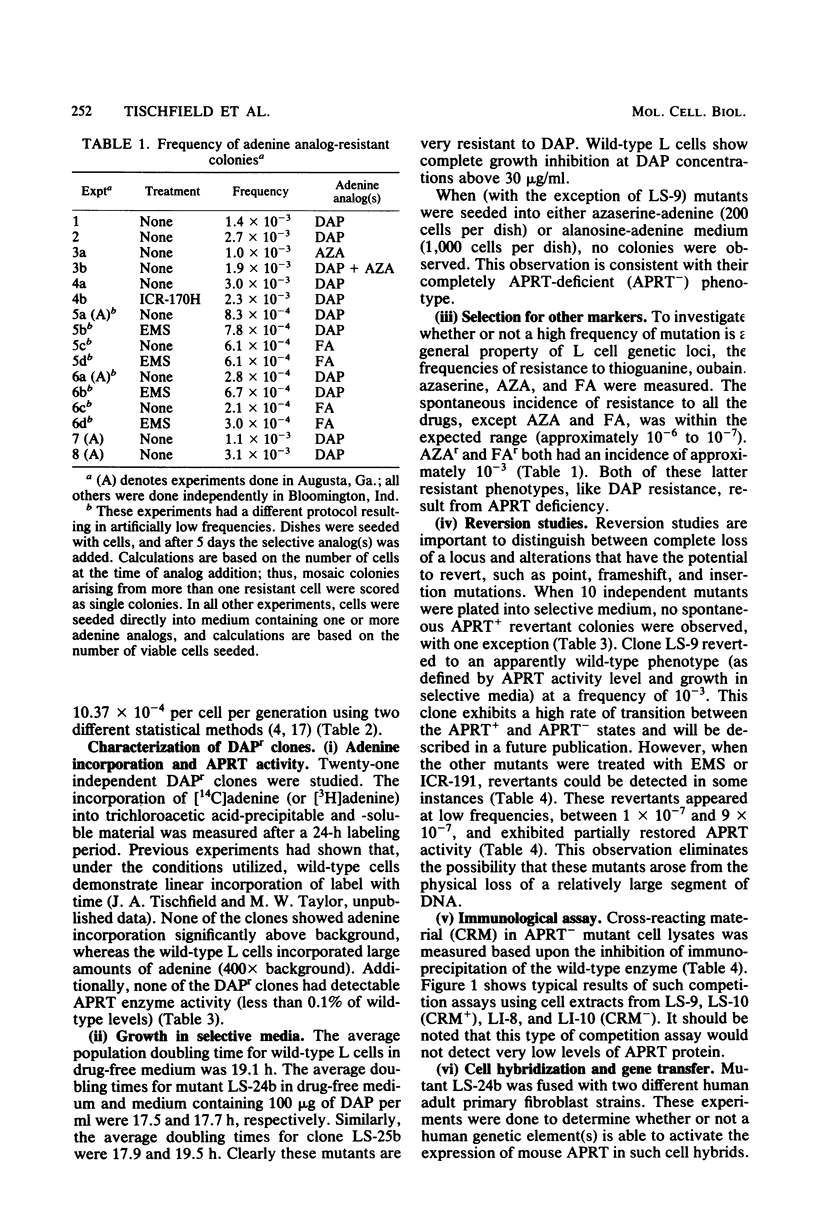
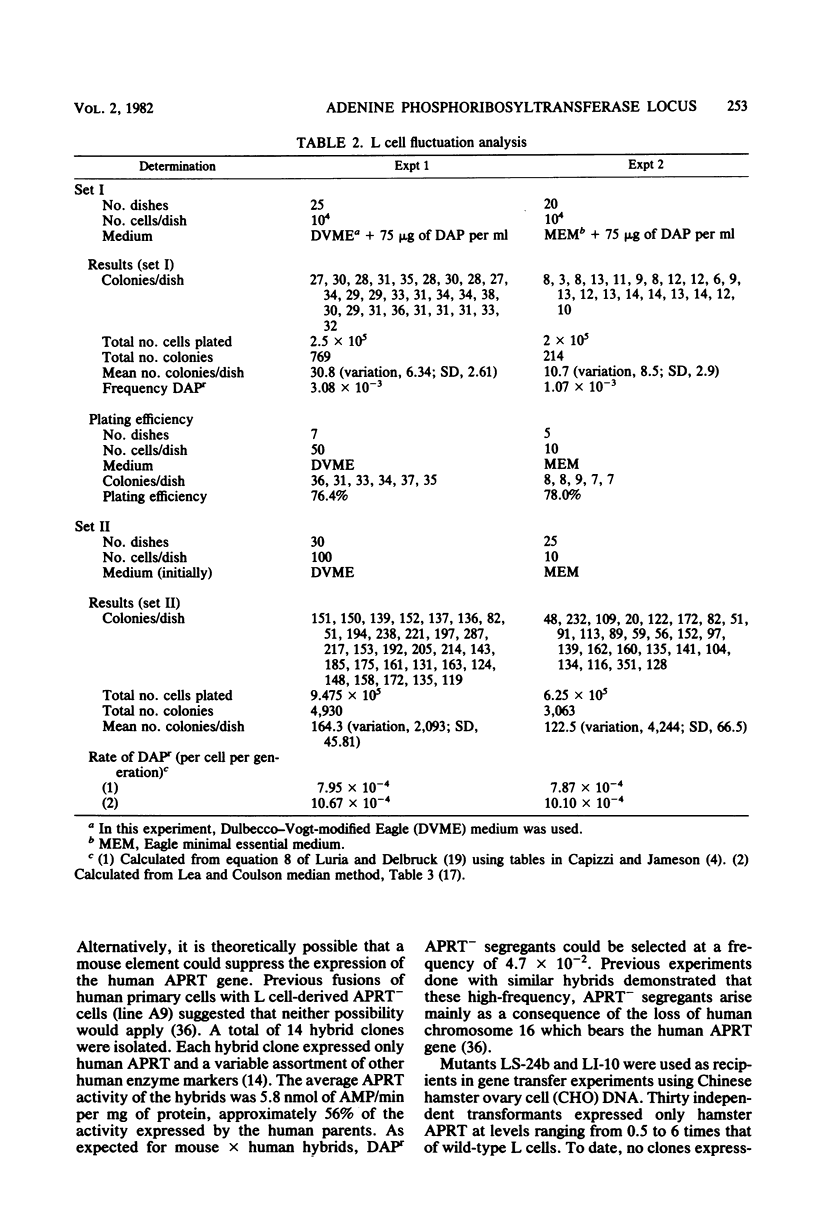
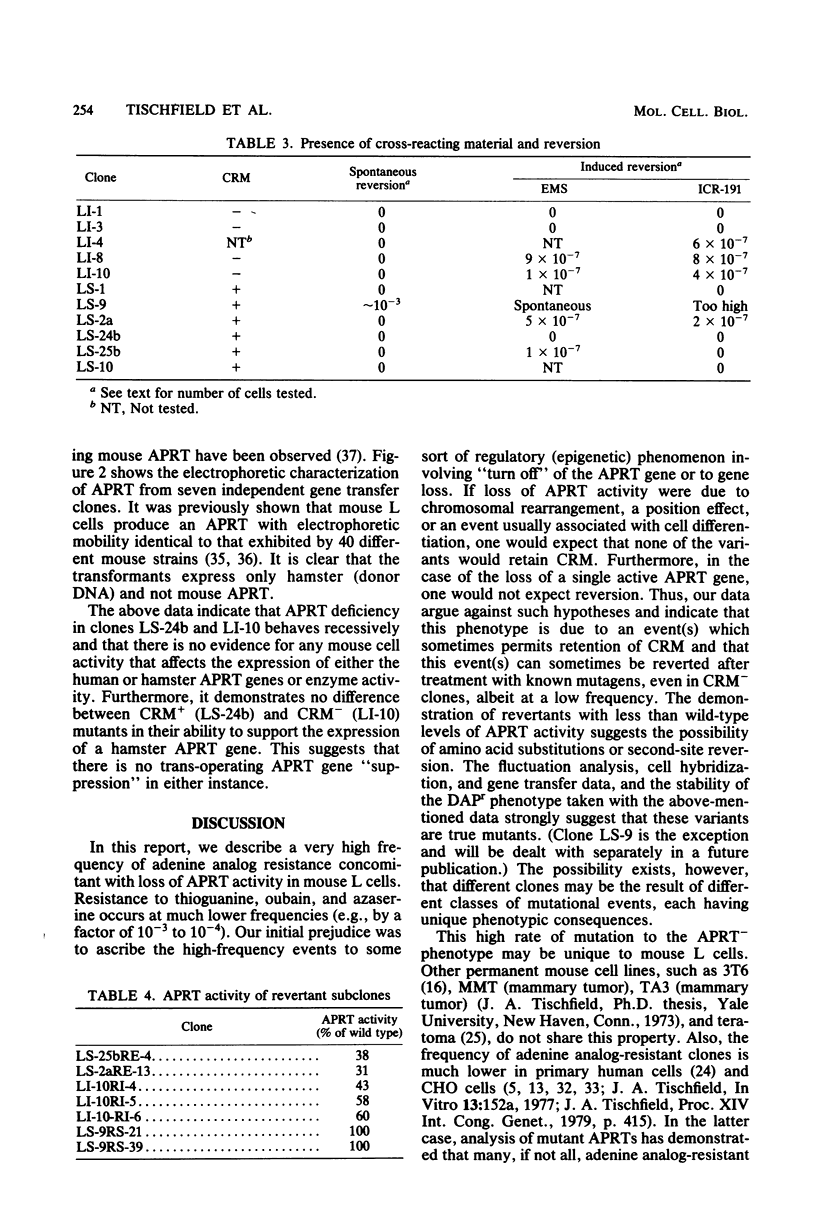
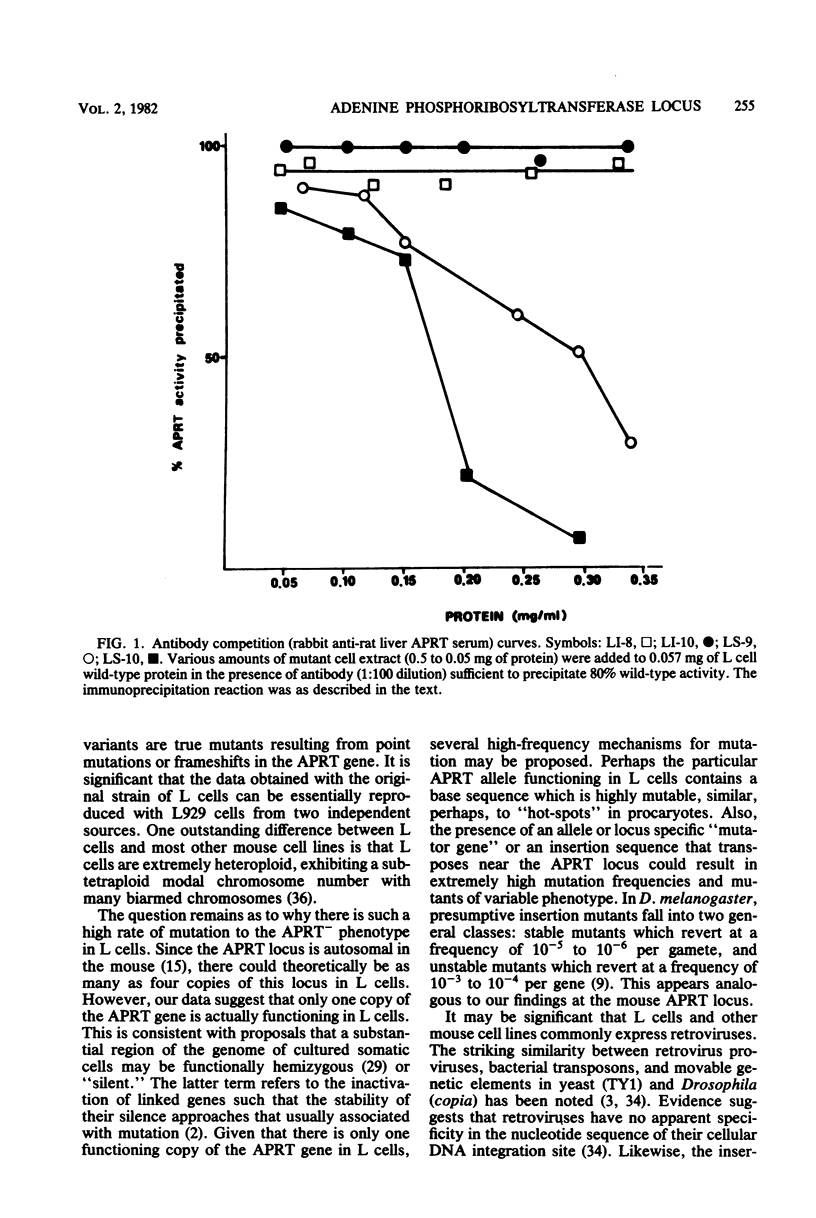
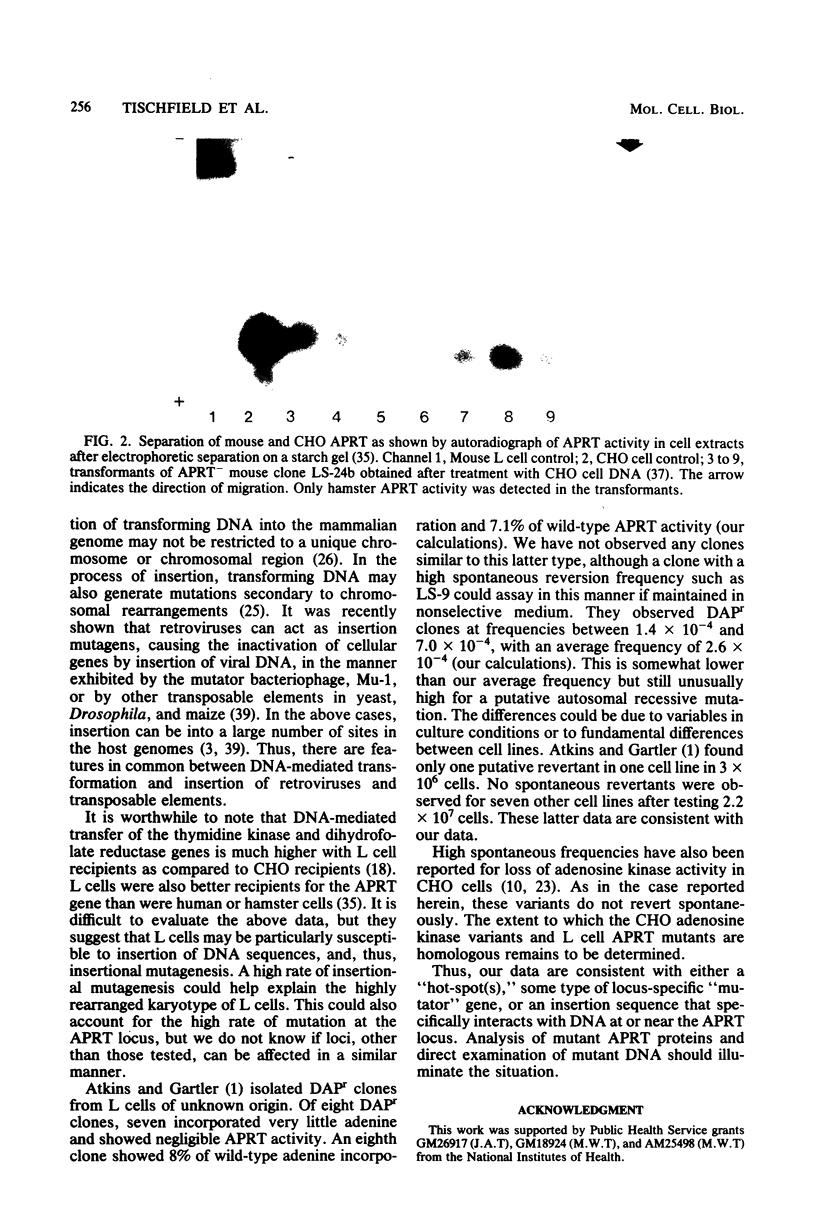
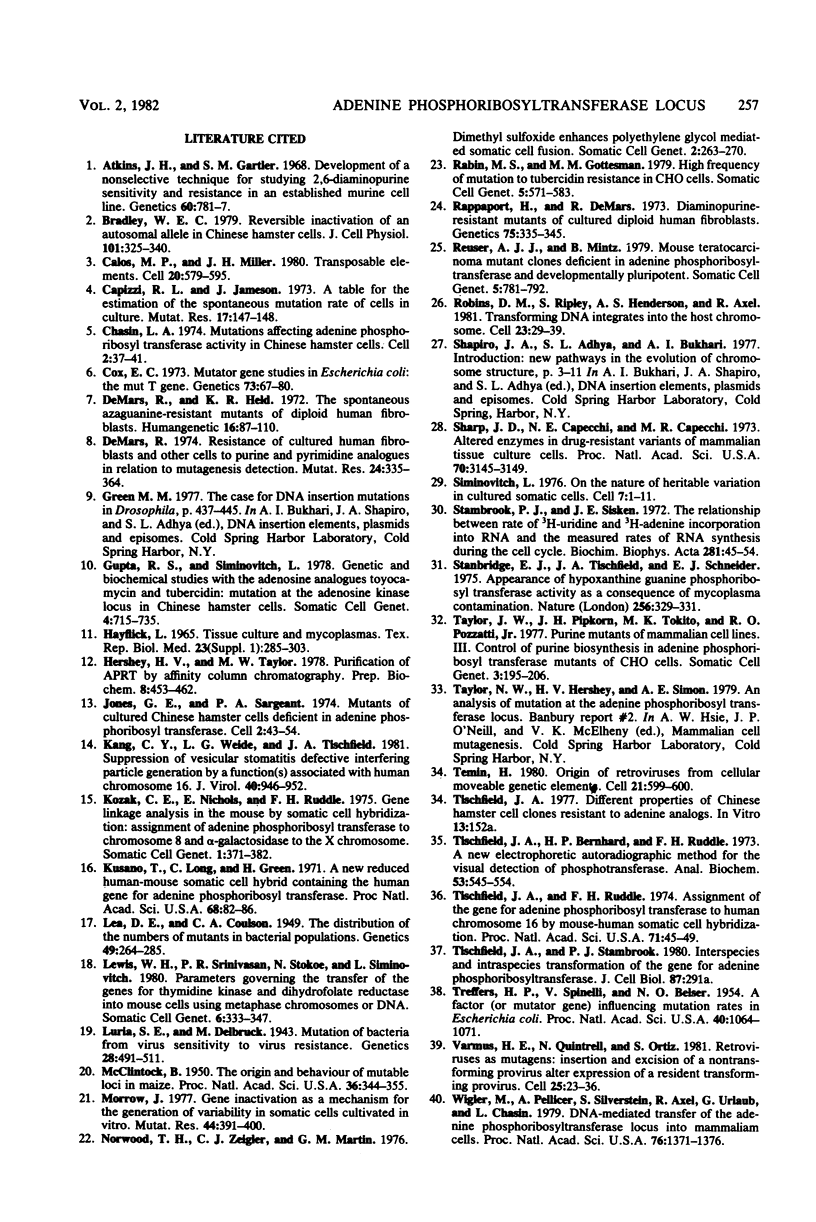
Images in this article
Selected References
These references are in PubMed. This may not be the complete list of references from this article.
- Atkins J. H., Gartler S. M. Development of a nonselective technique for studying 2, 6, diaminopurine resistance in an established murine cell line. Genetics. 1968 Dec;60(4):781–792. doi: 10.1093/genetics/60.4.781. [DOI] [PMC free article] [PubMed] [Google Scholar]
- Bradley W. E. Reversible inactivation of autosomal alleles in Chinese hamster cells. J Cell Physiol. 1979 Nov;101(2):325–340. doi: 10.1002/jcp.1041010212. [DOI] [PubMed] [Google Scholar]
- Calos M. P., Miller J. H. Transposable elements. Cell. 1980 Jul;20(3):579–595. doi: 10.1016/0092-8674(80)90305-0. [DOI] [PubMed] [Google Scholar]
- Capizzi R. L., Jameson J. W. A table for the estimation of the spontaneous mutation rate of cells in culture. Mutat Res. 1973 Jan;17(1):147–148. doi: 10.1016/0027-5107(73)90265-0. [DOI] [PubMed] [Google Scholar]
- Cox E. C. Mutator gene studies in Escherichia coli: the mutT gene. Genetics. 1973 Apr;73(Suppl):67–80. [PubMed] [Google Scholar]
- DeMars R., Held K. R. The spontaneous azaguanine-resistant mutants of diploid human fibroblasts. Humangenetik. 1972;16(1):87–110. doi: 10.1007/BF00393992. [DOI] [PubMed] [Google Scholar]
- DeMars R. Resistance of cultured human fibroblasts and other cells to purine and pyrimidine analogues in relation to mutagenesis detection. Mutat Res. 1974 Sep;24(3):335–364. doi: 10.1016/0027-5107(74)90180-8. [DOI] [PubMed] [Google Scholar]
- Gupta R. S., Siminovitch L. Genetic and biochemical studies with the adenosine analogs toyocamycin and tubercidin: mutation at the adenosine kinase locus in Chinese hamster cells. Somatic Cell Genet. 1978 Nov;4(6):715–735. doi: 10.1007/BF01543160. [DOI] [PubMed] [Google Scholar]
- Hayflick L. Tissue cultures and mycoplasmas. Tex Rep Biol Med. 1965 Jun;23(Suppl):285+–285+. [PubMed] [Google Scholar]
- Hershey H. V., Taylor M. W. Purification of adenine phosphoribosyltransferase by affinity chromatography. Prep Biochem. 1978;8(6):453–462. doi: 10.1080/00327487808061662. [DOI] [PubMed] [Google Scholar]
- Jones G. E., Sargent P. A. Mutants of cultured chinese hamster cells deficient in adenine phosphoribosyl transferase. Cell. 1974 May;2(1):43–54. doi: 10.1016/0092-8674(74)90007-5. [DOI] [PubMed] [Google Scholar]
- Kang C. Y., Weide L. G., Tischfield J. A. Suppression of vesicular stomatitis virus defective intefering particle generation by a function(s) associated with human chromosome 16. J Virol. 1981 Dec;40(3):946–952. doi: 10.1128/jvi.40.3.946-952.1981. [DOI] [PMC free article] [PubMed] [Google Scholar]
- Kozak C., Nichols E., Ruddle F. H. Gene linkage analysis in the mouse by somatic cell hybridization: assignment of adenine phosphoribosyltransferase to chromosome 8 and alpha-galactosidase to the X chromosome. Somatic Cell Genet. 1975 Oct;1(4):371–382. doi: 10.1007/BF01538668. [DOI] [PubMed] [Google Scholar]
- Kusano T., Long C., Green H. A new reduced human-mouse somatic cell hybrid containing the human gene for adenine phosphoribosyltransferase. Proc Natl Acad Sci U S A. 1971 Jan;68(1):82–86. doi: 10.1073/pnas.68.1.82. [DOI] [PMC free article] [PubMed] [Google Scholar]
- Lewis W. H., Srinivasan P. R., Stokoe N., Siminovitch L. Parameters governing the transfer of the genes for thymidine kinase and dihydrofolate reductase into mouse cells using metaphase chromosomes or DNA. Somatic Cell Genet. 1980 May;6(3):333–347. doi: 10.1007/BF01542787. [DOI] [PubMed] [Google Scholar]
- Luria S. E., Delbrück M. Mutations of Bacteria from Virus Sensitivity to Virus Resistance. Genetics. 1943 Nov;28(6):491–511. doi: 10.1093/genetics/28.6.491. [DOI] [PMC free article] [PubMed] [Google Scholar]
- McCLINTOCK B. The origin and behavior of mutable loci in maize. Proc Natl Acad Sci U S A. 1950 Jun;36(6):344–355. doi: 10.1073/pnas.36.6.344. [DOI] [PMC free article] [PubMed] [Google Scholar]
- Morrow J. Gene inactivation as a mechanism for the generation of variability in somatic cells cultivated in vitro. Mutat Res. 1977 Sep;44(3):391–400. doi: 10.1016/0027-5107(77)90097-5. [DOI] [PubMed] [Google Scholar]
- Norwood T. H., Zeigler C. J., Martin G. M. Dimethyl sulfoxide enhances polyethylene glycol-mediated somatic cell fusion. Somatic Cell Genet. 1976 May;2(3):263–270. doi: 10.1007/BF01538964. [DOI] [PubMed] [Google Scholar]
- Rabin M. S., Gottesman M. M. High frequency of mutation to tubercidin resistance in CHO cells. Somatic Cell Genet. 1979 Sep;5(5):571–583. doi: 10.1007/BF01542695. [DOI] [PubMed] [Google Scholar]
- Rappaport H., DeMars R. Diaminopurine-resistant mutants of cultured, diploid human fibroblasts. Genetics. 1973 Oct;75(2):335–345. doi: 10.1093/genetics/75.2.335. [DOI] [PMC free article] [PubMed] [Google Scholar]
- Reuser A. J., Mintz B. Mouse teratocarcinoma mutant clones deficient in adenine phosphoribosyltransferase and developmentally pluripotent. Somatic Cell Genet. 1979 Nov;5(6):781–792. doi: 10.1007/BF01542641. [DOI] [PubMed] [Google Scholar]
- Robins D. M., Ripley S., Henderson A. S., Axel R. Transforming DNA integrates into the host chromosome. Cell. 1981 Jan;23(1):29–39. doi: 10.1016/0092-8674(81)90267-1. [DOI] [PubMed] [Google Scholar]
- Sharp J. D., Capecchi N. E., Capecchi M. R. Altered enzymes in drug-resistant variants of mammalian tissue culture cells. Proc Natl Acad Sci U S A. 1973 Nov;70(11):3145–3149. doi: 10.1073/pnas.70.11.3145. [DOI] [PMC free article] [PubMed] [Google Scholar]
- Siminovitch L. On the nature of hereditable variation in cultured somatic cells. Cell. 1976 Jan;7(1):1–11. doi: 10.1016/0092-8674(76)90249-x. [DOI] [PubMed] [Google Scholar]
- Stambrook P. J., Sisken J. E. The relationship between rates of ( 3 H)uridine and ( 3 H)adenine incorporation into RNA and the measured rates of RNA synthesis during the cell cycle. Biochim Biophys Acta. 1972 Sep 29;281(1):45–54. doi: 10.1016/0005-2787(72)90186-4. [DOI] [PubMed] [Google Scholar]
- Stanbridge E. J., Tischfield J. A., Schneider E. L. Appearance of hypoxanthine guanine phosphoribosyltransferase activity as a consequence of mycoplasma contamination. Nature. 1975 Jul 24;256(5515):329–331. doi: 10.1038/256329a0. [DOI] [PubMed] [Google Scholar]
- Taylor M. W., Pipkorn J. H., Tokito M. K., Pozzatti R. O., Jr Purine mutants of mammalian cell lines: III. Control of purine biosynthesis in adenine phosphoribosyl transferase mutants of CHO cells. Somatic Cell Genet. 1977 Mar;3(2):195–206. doi: 10.1007/BF01551814. [DOI] [PubMed] [Google Scholar]
- Temin H. M. Origin of retroviruses from cellular moveable genetic elements. Cell. 1980 Oct;21(3):599–600. doi: 10.1016/0092-8674(80)90420-1. [DOI] [PubMed] [Google Scholar]
- Tischfield J. A., Bernhard H. P., Ruddle F. H. A new electrophoretic-autoradiographic method for the visual detection of phosphotransferases. Anal Biochem. 1973 Jun;53(2):545–554. doi: 10.1016/0003-2697(73)90105-x. [DOI] [PubMed] [Google Scholar]
- Tischfield J. A., Ruddle F. H. Assignment of the gene for adenine phosphoribosyltransferase to human chromosome 16 by mouse-human somatic cell hybridization. Proc Natl Acad Sci U S A. 1974 Jan;71(1):45–49. doi: 10.1073/pnas.71.1.45. [DOI] [PMC free article] [PubMed] [Google Scholar]
- Treffers H. P., Spinelli V., Belser N. O. A Factor (or Mutator Gene) Influencing Mutation Rates in Escherichia Coli. Proc Natl Acad Sci U S A. 1954 Nov;40(11):1064–1071. doi: 10.1073/pnas.40.11.1064. [DOI] [PMC free article] [PubMed] [Google Scholar]
- Varmus H. E., Quintrell N., Ortiz S. Retroviruses as mutagens: insertion and excision of a nontransforming provirus alter expression of a resident transforming provirus. Cell. 1981 Jul;25(1):23–36. doi: 10.1016/0092-8674(81)90228-2. [DOI] [PubMed] [Google Scholar]
- Wigler M., Pellicer A., Silverstein S., Axel R., Urlaub G., Chasin L. DNA-mediated transfer of the adenine phosphoribosyltransferase locus into mammalian cells. Proc Natl Acad Sci U S A. 1979 Mar;76(3):1373–1376. doi: 10.1073/pnas.76.3.1373. [DOI] [PMC free article] [PubMed] [Google Scholar]



